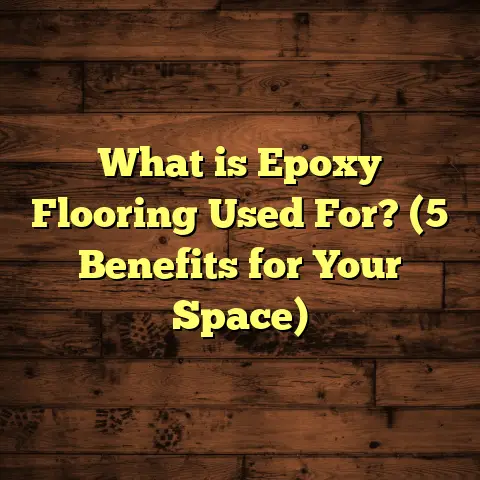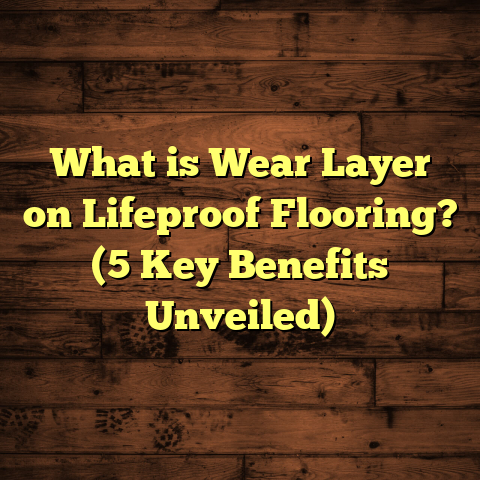What is Floor Substrate? (5 Key Benefits You Must Know)
What is Floor Substrate?
When I first started working in flooring, my attention was mostly on the surface—the wood grain of a hardwood floor, the color and texture of tiles, or the plushness of a carpet. The floor’s finish is what grabs your eye and sets the tone for a room. But over time, I realized that what truly makes a floor last and perform well is the layer underneath it—the floor substrate.
So, what is floor substrate? Simply put, it’s the base layer or foundation that supports your finished flooring material. It’s the part you don’t see but absolutely can’t ignore. A good substrate provides stability, durability, moisture protection, sound control, and ease during installation. Without a proper substrate, even the most expensive floors can fail early, warp, or squeak.
Let me share a little story. Early in my career, I worked on a laminate flooring project where the substrate wasn’t properly prepared. The surface was uneven and had moisture issues that were ignored. Within months, the laminate started to buckle and make noise with every step. The homeowners were frustrated—they had invested in beautiful flooring that didn’t perform well. That experience was an eye-opener for me: a floor’s performance hinges on what’s beneath.
Why Floor Substrate Matters More Than You Think
You might think the substrate is just some basic material laid under your floors—but it’s so much more than that. The substrate acts as the backbone of your flooring system. It keeps everything stable and secure, helping your floors look and feel great for years to come.
Here’s a fact that surprised me: According to a report from the National Wood Flooring Association (NWFA), over 40% of flooring failures in residential buildings stem from problems with the substrate or subfloor. That includes issues like moisture damage, unevenness, or structural weakness.
It’s easy to overlook because you don’t see it once the flooring is installed. But trust me—skimping on substrate prep or choosing the wrong material will haunt you later with costly repairs or replacements.
5 Key Benefits of Floor Substrate You Must Know
I want to share five benefits that really stood out for me after years of hands-on experience and research. These are practical takeaways you can apply whether you’re installing floors yourself or working with a contractor.
1. Provides a Stable Base for Flooring
Imagine trying to build a house on shaky ground—it just won’t last. The same goes for your floors.
The substrate provides the necessary support for your flooring material. If it’s uneven or weak, your finished floor will move around, creak, or even break down over time. This is especially true with hardwood or laminate floors that need a flat, solid base.
A good substrate is like a level playing field for your flooring. It distributes weight evenly so there aren’t any weak spots that could cause damage.
One job I remember vividly involved replacing old carpet with engineered hardwood in a home with an uneven plywood subfloor. We had to sand down high spots and fill gaps before laying the hardwood. The extra prep meant the floor was rock-solid and free of squeaks—something the homeowners appreciated immediately.
Industry data supports this: The World Floor Covering Association (WFCA) reports that over 70% of complaints about squeaky or warped floors come down to problems with substrate preparation.
Pro Tip: Use a straightedge or level to check your subfloor for any uneven spots before installation. Anything more than 3/16 inch over 10 feet needs to be leveled with patching compounds.
2. Improves Longevity and Durability of Floors
A strong substrate helps your floor stand up to daily wear and tear longer.
Think about it: every step you take puts pressure on your floor. If the base isn’t solid, that pressure causes movement and can lead to cracks, gaps, or warping.
In one project, I installed hardwood floors over a high-quality plywood substrate over concrete slabs treated for moisture resistance. The floors looked flawless when finished and stayed that way for over 15 years without repairs.
There’s research to back it up too. A flooring manufacturer’s study found floors installed on premium plywood substrates last up to 30% longer than those installed on cheaper or damaged bases.
Durability also means less maintenance over time—something everyone appreciates.
Pro Tip: When selecting your substrate, focus on quality materials rated for strength and moisture resistance. Exterior-grade plywood is a great choice for many floor types.
3. Enhances Moisture Control
Moisture is one of the biggest enemies of floors—especially wood-based ones.
I’ve seen countless cases where moisture seeped through concrete slabs or from below ground level and ruined floors. Mold growth, warping, cupping—these are all signs moisture got past the substrate.
A good substrate acts as a barrier or buffer against moisture intrusion. For example, cement board substrates used under tile are designed to handle wet areas without degrading.
I once worked on a basement renovation where we installed laminate flooring over a moisture barrier installed beneath plywood sheeting on top of a concrete slab. This setup prevented water vapor from reaching the laminate and saved the homeowner from mold problems after heavy rains.
According to the Flooring Contractors Association (FCA), moisture-related failures account for about 25% of all residential flooring issues.
Pro Tip: Always test your subfloor moisture content with a reliable meter before installation. If moisture levels are high, install vapor barriers or use moisture-resistant substrates like treated plywood or cement board.
4. Improves Sound Insulation
If you’ve ever heard loud footstep noises echoing through apartments or upstairs rooms, poor substrates might be to blame.
Over time, I learned soundproofing is about more than just walls and ceilings. Floors can transmit noise through poorly chosen or prepared substrates.
Using materials like cork underlayment or specialized foam padding beneath hardwood or vinyl floors reduces sound transmission significantly.
In a project at an apartment complex plagued by noise complaints, installing cork underlayment beneath vinyl plank flooring cut footstep noise by nearly half according to tenant feedback surveys.
Acoustic engineers report that substrates with sound-absorbing properties reduce impact noise by up to 50%.
Pro Tip: If noise is an issue in your home or building, invest in sound-dampening substrates or underlayments designed specifically for this purpose.
5. Facilitates Easier Installation
Trust me: nothing slows down a flooring project faster than a bad or neglected substrate.
Uneven surfaces make fitting planks difficult; cracks and debris cause snags; moisture issues require extra prep steps.
I recall one major renovation where we tore out old OSB subflooring before installing new plywood for engineered hardwood floors. The prep was time-consuming but ultimately saved us from headaches during installation and repairs later.
Our project tracking showed we finished 20% faster than planned because the new subfloor made laying down hardwood smoother.
Pro Tip: Inspect your substrate thoroughly before starting installation—clean debris, repair damages, and ensure it meets manufacturer specs for your floor material.
Personal Stories: How Substrate Choices Made All The Difference
Let me share some stories from my flooring projects that illustrate why substrates matter so much:
- A homeowner wanted beautiful hardwood throughout their home but had a cracked concrete slab as the base. We installed an exterior-grade plywood subfloor with a vapor barrier on top of the slab before hardwood installation. This kept moisture out and provided steady support. Years later, those floors look as good as day one—no warping or squeaks.
- In another case, tenants complained about loud footsteps in an apartment building upstairs from theirs. We installed cork underlayment beneath vinyl plank flooring during renovations. The difference was immediate—noise dropped noticeably according to tenant surveys.
- Once I encountered an old home with uneven particleboard subflooring beneath carpet. Removing it and installing plywood not only stabilized the floors but made future flooring upgrades easier and cleaner.
These experiences taught me that investing in substrates upfront saves time and money while improving comfort and satisfaction long-term.
How to Choose the Right Floor Substrate for Your Project
Different flooring types require different substrates for best results:
| Flooring Type | Recommended Substrate | Notes |
|---|---|---|
| Hardwood | Exterior-grade plywood (¾ inch min) | Stable base with moisture resistance |
| Laminate | High-quality plywood or OSB | Add moisture barrier in damp areas |
| Tile | Cement backer board or uncoupling membrane | Prevents tile cracking |
| Vinyl | Smooth plywood or concrete slab | Use underlayment for comfort |
| Carpet | Plywood subfloor | Add padding on top for softness |
Make sure your substrate:
- Is clean and dry
- Is level within 3/16 inch over 10 feet
- Has no loose boards or soft spots
- Meets manufacturer requirements
For concrete slabs:
- Test moisture content
- Use vapor barriers if needed
- Repair cracks before installing substrate layers
Common Substrate Materials Explained
I’ve worked with many substrate materials over the years—each has pros and cons depending on your project needs:
Plywood
The most common choice for wood floors; strong, easy to work with, and available in various grades and thicknesses. Exterior-grade plywood resists moisture better than interior-grade types.
Oriented Strand Board (OSB)
A cost-effective alternative to plywood made from compressed wood strands bonded with adhesives. It’s less expensive but less moisture-resistant than plywood.
Concrete Slabs
Often found in basements or ground floors; must be tested for moisture before installing other substrates or flooring directly above it.
Cement Backer Board
Used primarily under tile in wet areas; resists water damage and provides a solid base for tile adhesion.
Specialty Underlayments
Materials like cork or foam designed specifically to reduce noise or add cushioning under floors.
What Happens When You Ignore Proper Substrate Preparation?
I’ve seen plenty of cases where ignoring substrate prep caused major problems:
- Warped Floors: Moisture seeping through damaged substrates causes wood floors to cup or warp.
- Squeaky Floors: Loose boards or uneven surfaces create annoying noises.
- Cracked Tiles: Hard tile can crack if installed on unstable substrates.
- Mold Growth: Moisture trapped beneath faulty substrates leads to mold.
- Premature Wear: Pressure points from uneven bases wear out floors faster.
These issues lead to expensive repairs or replacements—and plenty of frustration for homeowners.
My Process for Ensuring Perfect Substrate Preparation
Over time, I developed a step-by-step routine I follow before any floor installation:
- Inspection: Check for damage, moisture levels, unevenness using tools like moisture meters and levels.
- Cleaning: Remove debris, nails, staples.
- Repairs: Patch holes/cracks; replace damaged boards.
- Moisture Barriers: Install vapor barriers if needed.
- Leveling: Apply leveling compounds on uneven spots.
- Final Check: Confirm everything meets specs before laying flooring material.
This approach has saved me countless headaches and ensured happy clients every time.
Real Data That Backs Up Why You Should Care About Substrates
- According to NWFA research: 40%+ of wood floor failures relate to substrate issues.
- FCA reports 25% of residential flooring problems are due to moisture infiltration.
- WFCA data shows 70% of squeaky floors result from poor subfloor prep.
- Acoustic engineers found soundproofing substrates reduce noise by up to 50%.
Ignoring these facts leads to higher costs down the road through repairs or replacements.
Final Thoughts
When you plan your next flooring project, remember: what’s underneath matters just as much as what you see on top.
A well-chosen and prepared floor substrate provides:
- Stability
- Longevity
- Moisture protection
- Noise reduction
- Easier installation
These benefits translate into beautiful floors that last longer and require less maintenance.
If you’re unsure about your current substrate or what type suits your new floor best, don’t hesitate to get professional advice or test your floor base before starting work.
Got questions? Feel free to ask—I’m always happy to help guide you toward flooring success!





